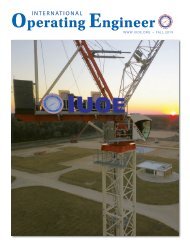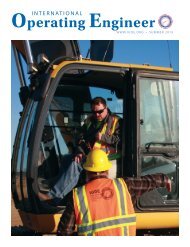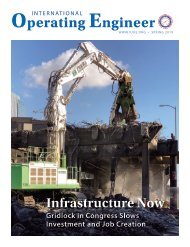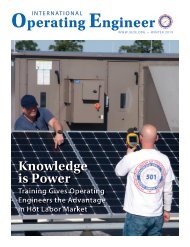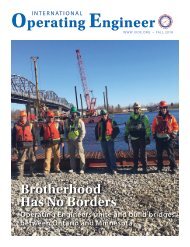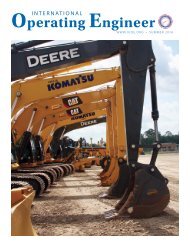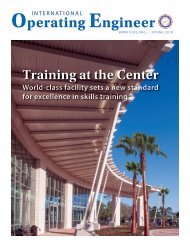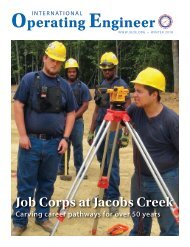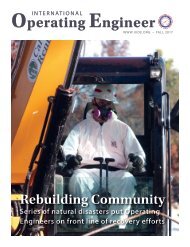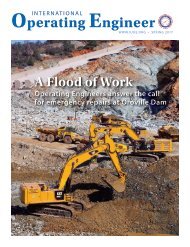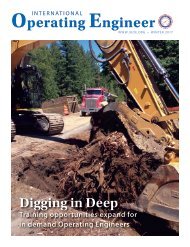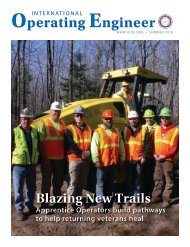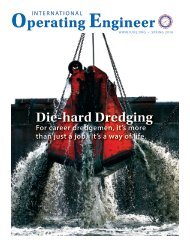125 Years Strong – An IUOE History
Celebrating the 125th Anniversary of the founding of the International Union of Operating Engineers
Celebrating the 125th Anniversary of the founding of the International Union of Operating Engineers
Create successful ePaper yourself
Turn your PDF publications into a flip-book with our unique Google optimized e-Paper software.
INTERNATIONAL UNION OF OPERATING ENGINEERS<br />
skilled workers <strong>–</strong> but were able to successfully<br />
meet those demands. What’s more, the<br />
international was able to systematically recruit<br />
and replace, mainly through attrition, a full<br />
force of international representatives in the<br />
field and new department heads at I.U.O.E.<br />
headquarters that year, about which the general<br />
president announced, “I am pleased to report<br />
that these appointments have already begun to<br />
improve our operations and alter jurisdictional<br />
standings for the I.U.O.E.”<br />
Keeping Good Times Rolling<br />
As positive momentum carried over<br />
into the second half of the 2010s,<br />
locals across the I.U.O.E. reported<br />
an increase in manhours throughout all of its<br />
traditional hoisting and portable work. Having<br />
Members of I.U.O.E. Marine Division Local No. 25, based in New<br />
Jersey, change cutter teeth on a hydraulic cutter suction dredge<br />
during a project in the union’s southern jurisdiction in 2015.<br />
experienced a shortage of crane operators in<br />
parts of the United States and Canada the year<br />
before as work proliferated, General President<br />
Callahan put out a call in the Winter 2015<br />
International Operating Engineer to push locals<br />
and the membership to organize and recruit<br />
non-union engineers into the union while<br />
work was plentiful, declaring:<br />
“Our commitment to organizing,<br />
in both hoisting & portable<br />
and stationary, is steadfast and<br />
we will continue to deploy the<br />
resources needed to compete in this<br />
expanding market.”<br />
To also further protect the health and safety<br />
of its members as they were out in the field<br />
and on an increasing number of jobsites, the<br />
union held the inaugural meeting of its new<br />
I.U.O.E. Safety and Health<br />
Committee on January 14,<br />
2015, at its headquarters<br />
in Washington, D.C. The<br />
initial 11-member team<br />
was composed of I.U.O.E.<br />
members representing<br />
various backgrounds such<br />
as crane operators, heavyequipment<br />
operators,<br />
stationary engineers,<br />
pipeline engineers and<br />
training instructors, and<br />
its mission was to represent<br />
I.U.O.E. interests during<br />
policy and rulemaking<br />
proceedings by providing<br />
real-world feedback and<br />
advice to I.U.O.E. Safety<br />
and Health Director<br />
Donald Booth.<br />
The union’s all-out<br />
programs were seemingly<br />
having their intended effect,<br />
as into 2015 its members<br />
were being employed in<br />
These participants in Project: Accelerate!, a free, seven-week program that introduces women to career opportunities in construction across the<br />
State of Michigan, spent the fourth week of their course in the summer of 2017 at the I.U.O.E. Local No. 324 Construction Career Center in Howell,<br />
Michigan, learning about and operating heavy equipment. With I.U.O.E. participation, the program, which is sponsored by a coalition of businesses,<br />
trade unions and colleges, allows women to gain hands-on experience with the tools of the trade, such as the cranes, excavators and other<br />
equipment these women operated at the 555-acre, world-class Local 324 training facility.<br />
areas that were historically not friendly toward<br />
unions. Perhaps most notably, union engineers<br />
were at work on construction of a number<br />
of large, complicated stadiums in states with<br />
so-called “right-to-work” laws, including the<br />
$1.6-billion, 71,000-seat Mercedes-Benz<br />
Stadium in downtown Atlanta, Georgia. Even<br />
without a project labor agreement, members<br />
of I.U.O.E. Local No. 926 worked for seven<br />
signatory contractors on the retractable-roof<br />
facility between the start of construction in<br />
May 2014 until it opened in August 2017.<br />
Elsewhere, in Florida <strong>–</strong> a notorious “rightto-work”<br />
state <strong>–</strong> operators from Local No.<br />
487 in Miami were involved in the two-year,<br />
$400-million renovation of that city’s Sun Life<br />
Stadium from 2014 until it was completed in<br />
January 2016, including installing a state-ofthe-art<br />
canopy around the top of the facility.<br />
I.U.O.E. members also built stadiums in<br />
more-union-friendly states (based on their<br />
lack of “right-to-work” laws) at that time,<br />
including the $1.3-billion Levi’s Stadium<br />
in California’s San Francisco Bay Area, for<br />
which operating engineers from Local No.<br />
3 were one of the first to break ground and<br />
had to deal with the state’s more-stringent<br />
seismic requirements during construction<br />
from April 2012 to July 2014. In Minnesota,<br />
after Local No. 49 had for years been an<br />
outspoken supporter of a new stadium, the<br />
local’s members helped build the $1.1-billion,<br />
enclosed U.S. Bank Stadium from December<br />
2013 to July 2016, during which it was the<br />
largest construction project in the state.<br />
New and emerging energy technologies also<br />
continued to bolster I.U.O.E. employment, and<br />
none more so than construction of the Block<br />
Island Wind Farm beginning in 2015, which<br />
would be the first commercial offshore wind<br />
farm in the United States when brought online<br />
in December 2016. Working under a project<br />
labor agreement with Deepwater Wind, more<br />
than 60 operating engineers with Local No. 57<br />
of Rhode Island and Local No. 25 placed five<br />
foundational installations for the 30-megawatt<br />
farm’s five turbines three miles off the coast of<br />
the state’s Block Island at depths of about 100<br />
feet in the Atlantic Ocean. After the engineers<br />
LABOR OMNIA VINCIT<br />
WORK CONQUERS ALL



